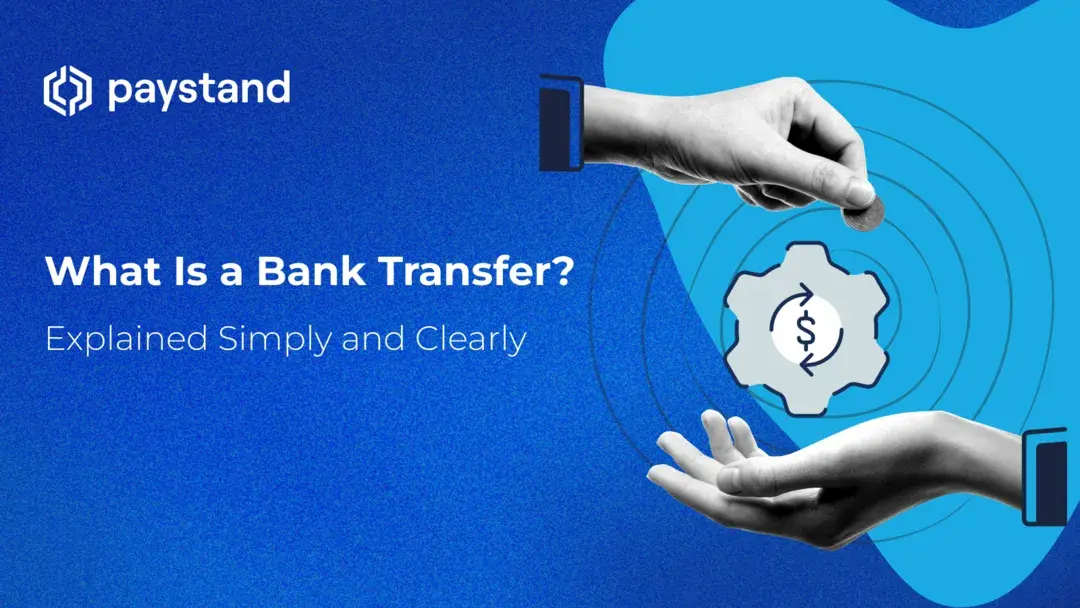What Is a Bank Transfer? Explained Simply and Clearly

Table of Contents
- What is a bank transfer?
- What is the difference between payment and transfer in banking?
- How does a bank transfer work?
- Accepting bank transfers as a business
- Is a bank transfer safe?
- Streamline your bank transfers with Paystand
Key Takeaways
- A bank transfer allows individuals and businesses to transfer money between bank accounts, both internally and externally.
- Key benefits of bank transfers include convenience, speed, security, and low costs, though challenges like time delays and fees exist, particularly for international transfers.
- Businesses can accept bank transfers by providing clear payment instructions and using platforms like Paystand for seamless integration.
- Bank transfers are secure, but precautions should be taken to avoid errors and phishing scams, and account monitoring is crucial for safety.
In today’s fast-paced financial landscape, digital payments have become essential for businesses looking to improve cash velocity and streamline operations. One common method, the bank transfer, allows organizations to move funds seamlessly between accounts, supporting domestic and international transactions. However, with the growing complexity of ERP payments, understanding the intricacies of bank transfers is crucial for optimizing your payment workflows.
Ready to uncover how these transfers can impact your financial operations and drive efficiency? Dive deeper into this guide to explore the benefits, challenges, and best practices for managing bank transfers.
What Is A Bank Transfer?
A bank transfer is a payment method that allows individuals and businesses to transfer money from one bank account to another. Bank transfers can be sent from one of your internal accounts to another, from your payments processing account to your bank account, and from your bank account to an external account.
Benefits and Challenges of Bank Transfers
There are several benefits to using bank transfers, including:
- Convenience: Bank transfers can be initiated online, through mobile banking, or by visiting a bank branch.
- Speed: Domestic bank transfers are typically processed within a few minutes.
- Security: Bank transfers are a secure way to send money, as they are protected by encryption and other security measures.
- Cost: Bank transfers are typically free or have a low fee.
However, there are also some potential drawbacks to using bank transfers, including:
- Time delays: International bank transfers can take several days to complete.
- Fees: Some banks may charge a fee for bank transfers, especially for international transfers.
- Limits: Banks may limit the money transferred in a single transaction.
What is the Difference Between Payment and Transfer in Banking?
In banking, the terms "payment" and "transfer" are often used interchangeably, but there are subtle distinctions between the two. Understanding these differences is crucial for effective finance management.
| Payment | Transfer |
|---|---|
| A transaction where funds are sent from one party to another to settle a debt or obligation. | Fund movement between accounts, typically within the same bank or financial institution. |
| Involves money exchange or its equivalent, such as a check, credit card, or electronic funds transfer. | Reallocation of funds between accounts without debt involvement. |
| They fulfill financial commitments like paying bills, buying goods or services, or repaying loans. | Used to consolidate funds, move money between savings and checking accounts, or allocate funds for specific purposes, such as an investment or emergency fund. |
💡Key Differences:
- Purpose: Payments fulfill obligations; transfers move funds between accounts.
- Sender and receiver: Payments involve a sender and a receiver, while transfers involve only one party moving funds between accounts.
- Settlement: Payments involve settling a debt or obligation, while transfers do not.
- Timing: Payments are processed quickly, while transfers take days, depending on the type and institution.
Understanding the difference between payments and transfers enables tracking financial obligations, allocating funds efficiently, and making informed money-use decisions.
Different Types of Bank Transfers
- ACH payments are common domestic bank transfers initiated online via the ACH network run by NACHA. The network enables direct deposits and payments to US financial institutions.
- Direct deposits are used for salaries, refunds, annuities, and interest. Entities and businesses use them more than individuals.
- Direct payments are made between bank accounts using the credit and debit system. The funds are withdrawn from the payer's account and deposited directly into the payee's account.
How Does a Bank Transfer Work?
The process of a bank transfer typically involves the following steps:
-
Initiation: The payer initiates the money transfer by providing the bank with instructions on the amount, destination account, and timing. Methods include online banking, mobile banking, or bank branch visits.
-
Verification: The bank verifies account details to ensure correct transfer.
-
Processing: The bank processes the transfer after verifying information, debiting the payer, and crediting the recipient.
-
Sending the money: The money is sent electronically through a bank and financial institution network until it reaches the recipient's bank.
-
Crediting the recipient's account: The recipient's bank credits the money to the recipient's account, and the transfer is complete.
Bank transfers can take a few minutes to several days to complete, depending on the banks involved and the type of transfer. Domestic transfers (within the same country) are typically processed more quickly than international ones.
What are the Details Needed for a Bank Transfer?
To complete a bank transfer, you'll typically need the following information:
-
Recipient’s name: Full name as registered with their bank.
-
Recipient’s bank account number: An account number to which to deposit the funds.
-
Recipient’s bank name and address: Name and location of the bank holding the recipient’s account.
-
Bank identification code: Depending on the country, you may need a SWIFT/BIC code for international transfers or a routing number for domestic ones.
-
Transfer amount: The exact amount you want to send.
-
Reference/Message: This is optional but useful for providing details to the recipient (e.g., invoice number).
-
Transfer fee: Check whether fees apply for domestic or international transfers.
-
Currency: For international transfers, confirm the currency.
How to Transfer Money to Another Bank Account
There are several ways to transfer money:
-
Online banking: Most banks offer online platforms where you can transfer funds to another account. Follow the instructions and provide the recipient’s details.
-
Mobile banking apps: Bank apps often make transfers even more convenient with easy interfaces.
-
Wire transfer: Often used for large amounts or international transfers, wire transfers usually come with fees.
-
Third-party transfer services: Services like PayPal, Venmo, or Western Union allow transfers without needing bank account numbers.
-
In-person: You can visit a bank branch to initiate a transfer using the required details.
Accepting Bank Transfers as a Business
As a business, accepting bank transfers is straightforward, but a clear process is crucial. Start by providing your bank details to your customers, including your account number, bank name, and, if needed for international payments, your SWIFT/BIC code. Including payment instructions on invoices can also streamline the process, guiding clients on how to make transfers efficiently.
To make things even easier, consider using payment platforms like Paystand, which integrate bank transfers into a seamless automated process. Transparency is essential—communicate any fees or exchange rates upfront. And, of course, always confirm when payments are received and notify your customers to keep everything running smoothly.
Is a Bank Transfer Safe?
Bank transfers are one of the safest ways to move money, thanks to the robust security measures banks have in place. However, you should still take some precautions. Always double-check the recipient’s details before sending money—mistakes can be difficult to reverse, especially with wire transfers. Stay vigilant against phishing scams targeting your bank information, and only use secure, encrypted banking websites or apps.
After the transfer, monitor your account to ensure the transaction was processed correctly. Banks often have fraud protection, but being proactive and cautious will go a long way in ensuring your transfers remain secure.
Streamline Your Bank Transfers with Paystand
Bank transfers are vital to modern financial operations, but managing them efficiently can be challenging. With Paystand’s digital payments platform, you can automate and simplify your ERP payments, increasing cash velocity while reducing friction. Ready to take control of your financial processes? Download our ebook, Digital Payments in the Supply Chain, and discover how Paystand can revolutionize your payment workflows today.






